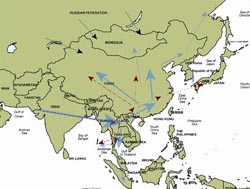

Tracing through human migration history with the help of genes, Dr. SU Bing and coworkers from the Kunming Institute of Zoology (KIZ), Chinese Academy of Sciences lately revealed the evidence of a much earlier modern human settlement in East Asia than people previously thought.
Genes tell the story of our ancient ancestors' migrations, experts say. When DNA is passed from one generation to the next, the recombination of DNA helices make each person unique from his or her parents. Some special pieces of DNA, however, remain virtually unaltered. One of these pieces is carried by the Y chromosome, which is passed only from father to son. Since the DNA in the Y chromosome does not mix with other DNA, it is like a genetic surname that allows men to trace their paternal lineages.
Y chromosome DNA is subject to occasional mutations that become inheritable genetic markers. After several generations, a particular genetic marker is carried by almost all inhabitants of the region in which it arose. When people leave that region, they carry the marker with them. By studying the genes of different indigenous populations, scientists can trace when and where a particular marker arose, and each marker contained in a person's DNA represents a location and migration pattern of that person's ancient ancestors.
For example, about 70% of English men, 95% of Spanish men, and 95% of Irish men have a distinctive Y-chromosome mutation known as M173. The distribution of people with this mutation, together with other DNA analyses, indicates that the men's ancestors moved north out of Spain into England and Ireland at the end of the last ice age.
According to Dr. Su, molecular evolution studies on the Y chromosome in Asia previously suggested that modern humans of African origin initially settled in mainland southern East Asia. Then, about 25,000 to 30,000 years ago, they migrated northward, spreading throughout East Asia. However, the fragmented distribution of one East-Asian-specific Y chromosome lineage (D-M174), which is found frequently only in Tibet, Japan and the Andaman Islands, is inconsistent with this scenario.
Dr. Su and his collaborators of the Comparative Genomics Group, KIZ-affiliated Key Laboratory of Cellular and Molecular Evolution therefore collected more than 5,000 male samples from 73 East Asian populations to reconstruct the D-M174 lineage. The results suggested that D-M174 represents an extremely ancient lineage of modern humans in East Asia, and that there is a deep divergence between northern and southern populations.
To explain this, the researchers proposed that D-M174 has a southern origin and its northward expansion occurred about 60,000 years ago, before the northward migration of other major East Asian lineages. The bad weather of the last ice age and the expansion of Han culture in the New Stone Age (some 10,000 years ago) were likely the key factors leading to the current relic distribution of D-M174 in East Asia.
The study, which was reported by
BMC Biology online, also indicated that the Tibetan and Japanese populations are the admixture of two ancient populations represented by two major East Asian specific Y chromosome lineages, the O and D.








